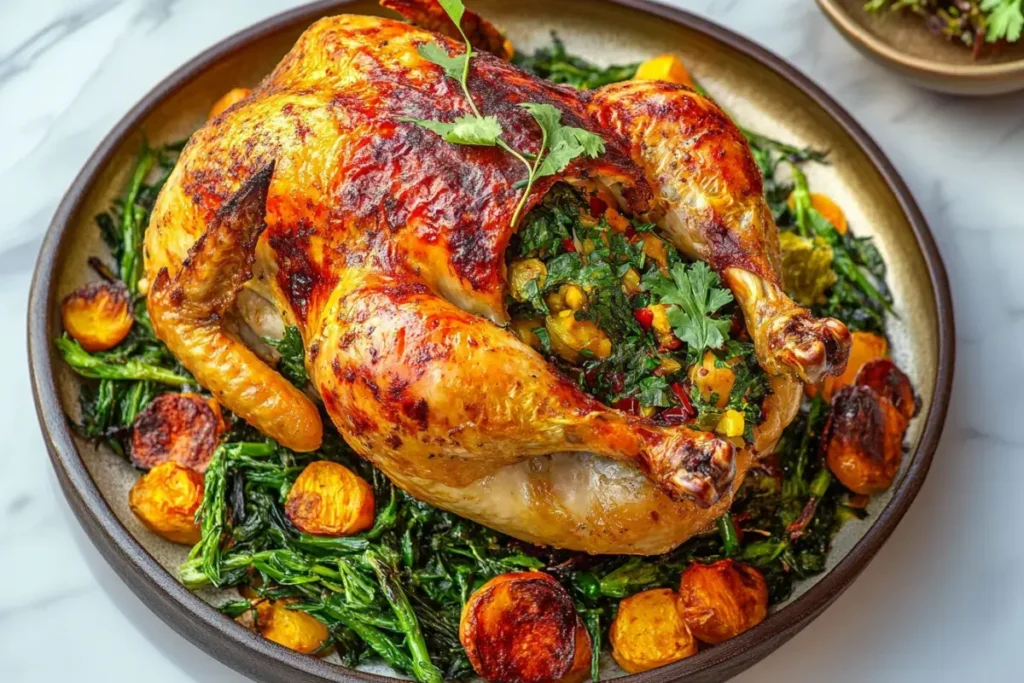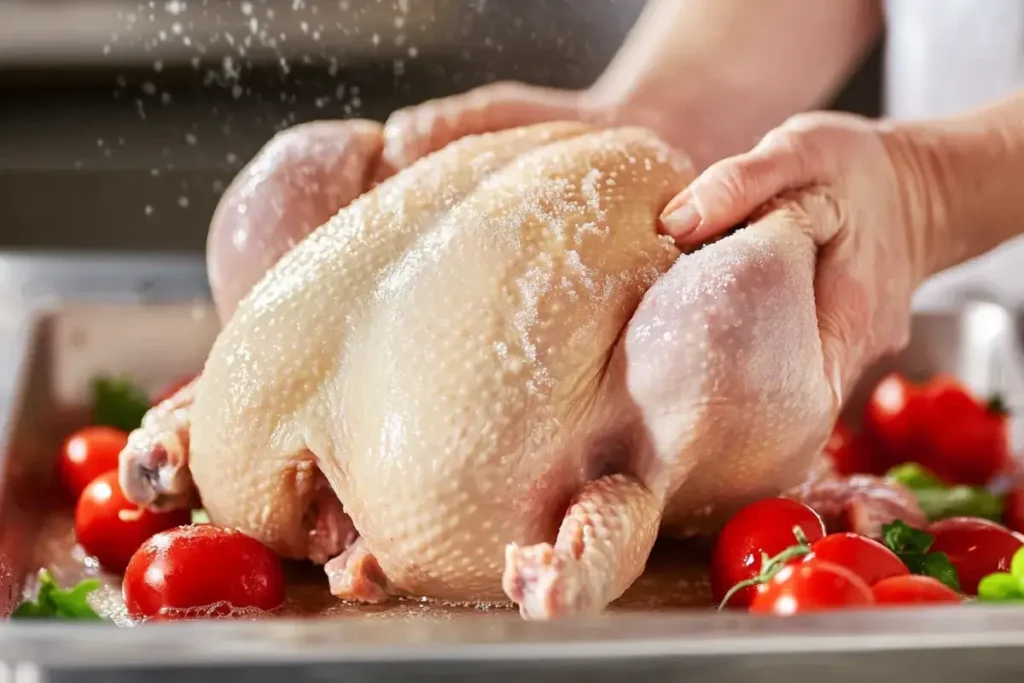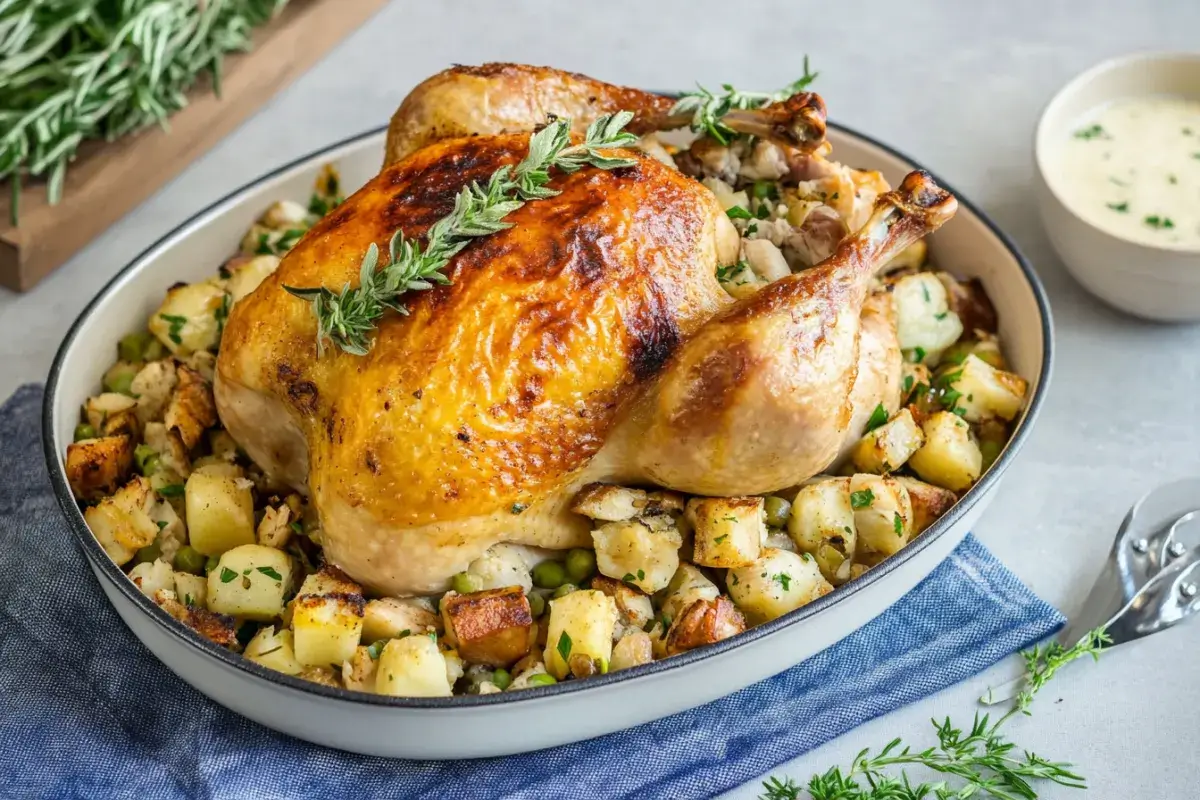When cooking chicken, adding stuffing is more than just tradition—it’s a way to make the dish taste better and keep the meat juicy. Whether you’re roasting a whole chicken for a special meal or making a simple weeknight dinner, stuffing can take your dish to the next level. But what’s the actual purpose of stuffing in chicken? Let’s dive deeper into the reasons behind this popular technique.
Historical Significance of Stuffing in Poultry
The practice of stuffing poultry has ancient roots, going back to civilizations like the Romans and Greeks. These early cultures would stuff meats with basic ingredients like bread, herbs, and even vegetables to add flavor and stretch the meal further. Stuffing was not only about taste but also about making food more filling, especially when meat was a luxury and needed to feed many people.
Over the centuries, stuffing evolved. By the Middle Ages in Europe, cooks were experimenting with more flavorful and exotic ingredients such as spices and dried fruits. It wasn’t just about filling the chicken but enhancing it with complex flavors. Today, this tradition continues, with stuffing ranging from simple bread and herb mixtures to more modern recipes that include vegetables, fruits, and nuts.
Why Stuff Chicken: Flavor, Moisture, and Texture
The core reason to stuff chicken is to improve its overall taste, texture, and juiciness. Stuffing acts as an enhancer that interacts with the chicken during cooking, infusing it with flavors and moisture that it wouldn’t have on its own.
Infusing Flavor with Stuffing
One of the main purposes of stuffing is to infuse flavor into the chicken. When you fill the cavity with ingredients like herbs, spices, and aromatics (such as onion or garlic), the steam and heat inside the chicken help these flavors to blend into the meat.
The stuffing absorbs the juices released by the chicken, creating a deeper, richer flavor that’s spread evenly through every bite. For instance, herbs like sage, rosemary, and thyme—often used in classic stuffing recipes—are well-known for their strong, savory notes that perfectly complement roasted chicken.
- Tip: Always season your stuffing well to ensure it adds the right amount of flavor to the chicken. This could include adding salt, pepper, and even a bit of chicken broth for extra depth.
By creating a well-balanced stuffing mixture, you ensure that both the chicken and the stuffing are delicious. This flavor exchange makes the dish much more cohesive.
Moisture Retention through Chicken Juices
In addition to flavor, stuffing helps retain moisture in the chicken. As the chicken cooks, its natural juices are released. When the cavity is stuffed, those juices are absorbed into the stuffing rather than evaporating away. This keeps the chicken, especially lean cuts like the breast, from drying out, ensuring it remains tender throughout the cooking process.
- Tip: Be sure not to overstuff the chicken. Overstuffing can lead to uneven cooking, which can make the chicken dry or prevent the stuffing from cooking thoroughly.
Creating Texture with Stuffing
Another purpose of stuffing in chicken is to add texture, creating a contrast between the tender meat and the stuffing’s crispy or soft elements. While the chicken itself is soft and juicy, the stuffing provides a nice contrast with a mix of crispy and tender elements. For instance, bread-based stuffing can be slightly crisp on the outside while staying soft on the inside. Adding nuts or vegetables like celery and carrots can bring an extra crunch, giving the dish a more dynamic mouthfeel.
- Textural Tip: Choose a sturdy bread for your stuffing, like sourdough or baguette, which can hold up to the moisture from the chicken without becoming soggy.
By blending textures, you create a more interesting dish that offers a different experience with each bite.
How Stuffing Evolved Over Time
From Simple Ingredients to Modern Innovations
In the past, stuffing was made with basic ingredients like breadcrumbs, herbs, and sometimes meat. However, today’s stuffing recipes are much more diverse. Many cooks now experiment with fruits, nuts, and even cheese to give their stuffing unique flavor profiles. For example, adding dried cranberries or apricots can give the stuffing a sweet note, balancing the savory taste of the chicken.
Similarly, the use of vegetables and herbs has grown, with options like spinach, sun-dried tomatoes, and artichokes providing a fresher, lighter stuffing. These modern innovations allow for a variety of flavors and textures, making stuffed chicken dishes versatile enough for everyday meals and special occasions.
Common Stuffing Ingredients and Their Roles
- Herbs: Sage, thyme, rosemary, and parsley are the most common. They add an earthy, savory aroma that complements chicken.
- Bread: Acts as a base that soaks up the chicken’s juices. Use stale bread to ensure it absorbs liquid without becoming mushy.
- Fruits and Nuts: Dried fruits like cranberries or raisins add sweetness, while nuts like walnuts or pecans add crunch.
The Benefits of Stuffing Chicken
Stuffing serves multiple purposes beyond just filling the bird. It:

- Enhances flavor: Stuffing allows for a mix of flavors that naturally complement the chicken.
- Locks in moisture: By keeping the juices inside, stuffing ensures the meat stays tender.
- Adds texture: The combination of soft chicken and the varied textures of stuffing creates a more interesting dish.
How to Properly Stuff a Chicken
Stuffing a chicken is straightforward, but following a few key steps ensures success:
- Clean the Chicken: Always wash the chicken inside and out before stuffing it.
- Cool the Stuffing: Make sure the stuffing is completely cooled before inserting it into the cavity. This reduces the risk of bacterial growth.
- Don’t Overstuff: Leave some room inside the cavity for the stuffing to expand as it absorbs moisture from the chicken.
- Secure the Chicken: Use kitchen twine or toothpicks to close the cavity and keep the stuffing inside during roasting.
For more detailed safety tips and best practices on how to properly stuff poultry, you can check out these stuffing safety tips.
Stuffing chicken isn’t just about adding an extra element to the dish. It’s about enhancing the flavor, moisture, and texture of the chicken in ways that would otherwise be impossible. By experimenting with different ingredients and following proper stuffing techniques, you can create a dish that’s deeply flavorful and satisfying. Stuffing chicken is more than a cooking technique—it’s an art that allows you to create a meal that’s truly memorable.
Classic Bread and Herb Stuffing
The classic bread and herb stuffing is probably the most widely used recipe for stuffing chicken. This stuffing typically uses bread as the base, mixed with flavorful herbs like sage, thyme, and rosemary, along with onions and garlic to provide an aromatic base.
Key Ingredients for Traditional Stuffing
- Bread: Stale bread works best as it absorbs moisture better. You can use a variety of breads like sourdough, whole grain or French bread, depending on your preference.
- Herbs: Sage, rosemary, thyme, and parsley are the most common choices. These herbs give a robust, savory aroma to the stuffing.
- Onions and Garlic: These aromatics add depth to the flavor.
- Chicken Broth: Adding broth helps to keep the stuffing moist while it cooks inside the chicken, ensuring that it doesn’t dry out.
Using fresh ingredients is key to making the stuffing taste bright and flavorful. Opt for homemade breadcrumbs if possible, as they absorb moisture without becoming too soggy.
Tips for Adding Flavor to Traditional Stuffing
- Add a little extra broth for more moisture if your bread is particularly dry.
- Consider sautéing your onions and garlic before adding them to the stuffing mix. This enhances their natural sweetness and makes the stuffing more flavorful.
Modern Variations of Stuffing
While traditional stuffing is always a crowd-pleaser, there are plenty of modern variations you can try to add a twist to your dish. Stuffing can be as creative as you like, with endless ingredient possibilities that range from savory to slightly sweet.
Fruit and Nut Stuffing for a Sweet Twist
Incorporating dried fruits and nuts into your stuffing can bring a delightful contrast of sweet and savory. This type of stuffing works particularly well for festive or holiday meals but can also add an unexpected flavor punch to a simple weeknight dinner. Here are some popular ingredients for fruit and nut stuffing:
- Dried Cranberries or Apricots: These fruits add a touch of sweetness, complementing the savory flavors of the chicken.
- Pecans or Walnuts: Nuts provide a crunchy texture and enhance the richness of the stuffing.
These combinations bring a delightful contrast to the dish, with the sweetness of the fruit balancing out the savory notes of the chicken and herbs.
Vegetable-Based Stuffing for a Lighter Option
For a lighter and more vegetable-forward stuffing, you can incorporate fresh ingredients like spinach, zucchini, and mushrooms. These veggies add both flavor and nutrition, making this stuffing variation a healthier alternative. Here’s how to make it:
- Fresh Spinach: Sautéed spinach adds a mild earthiness that pairs well with chicken.
- Mushrooms: Give the stuffing a savory, umami-rich flavor.
- Celery: Adds crunch and light flavor without overwhelming the stuffing.
You can experiment with other vegetables, such as carrots or bell peppers, to suit your taste. The lighter nature of this stuffing also makes it ideal for those who want something less carb-heavy but still flavorful.
International Variations of Stuffing
Stuffing is far from a Western concept. Across the globe, various cultures have their own take on how to stuff chicken:
- Mediterranean Stuffing: This version often includes ingredients like olives, feta cheese, and sun-dried tomatoes, giving the stuffing a tangy, salty flavor profile. The mix of herbs like oregano and basil complements this beautifully.
- Cornbread Stuffing: In Southern cuisine, cornbread is a popular base for stuffing. It’s mixed with ingredients like jalapeños, cheddar cheese, and sometimes vegetables like corn to give it a hearty, spicy flavor.
Experimenting with these different stuffing variations can open up a whole new world of flavors and allow you to personalize the dish for any occasion.
For a delicious twist on stuffing, try a chicken stuffing casserole, which combines the flavors of stuffing with the ease of a baked dish.
Proper Techniques for Stuffing Chicken
Even the best stuffing recipe can fall flat if it’s not prepared properly. To make sure your chicken and stuffing turn out perfectly, follow these key steps:

Clean and Prepare the Chicken
Before stuffing your chicken, always wash it inside and out under cold water and then pat it dry with paper towels. This ensures that the chicken is clean and ready for stuffing.
- Important Tip: Stuff the chicken right before cooking. Never pre-stuff the chicken, as this can increase the risk of bacterial growth.
Cool the Stuffing Before Use
Make sure your stuffing is completely cooled before inserting it into the chicken. Hot stuffing can create a warm environment inside the raw chicken, which can promote the growth of harmful bacteria.
- Key Safety Tip: Always use a food thermometer to ensure that both the stuffing and chicken reach a safe internal temperature of 165°F (74°C).
Avoid Overstuffing
It’s tempting to pack the chicken full of stuffing, but overstuffing can lead to uneven cooking. The chicken will cook slower if it’s overfilled, and the stuffing may not reach the proper temperature. This could result in undercooked chicken, which poses a health risk.
Common Mistakes to Avoid
While stuffing chicken is a straightforward process, there are a few common mistakes that can affect the outcome of your dish:
- Overstuffing the Chicken: This can cause the stuffing to expand too much, making the chicken cook unevenly.
- Not Securing the Chicken Properly: After stuffing, you need to use kitchen twine or toothpicks to close the cavity. This prevents the stuffing from falling out during cooking.
- Not Checking the Internal Temperature: The internal temperature of both the stuffing and chicken needs to reach 165°F to ensure that it’s safe to eat.
FAQs on Stuffing Chicken
Why is stuffing important?
Stuffing enhances the flavor of the chicken by infusing it with the rich aromas of herbs, spices, and any other ingredients you add. It also helps keep the chicken moist while cooking.
Can you stuff a chicken with raw ingredients?
No, it’s important to use fully cooked or cooled ingredients in your stuffing to avoid bacterial growth during cooking. Always cool the stuffing before placing it inside the chicken.
Does stuffing slow down cooking?
Yes, stuffing a chicken can slow down the cooking process because the heat needs to penetrate through the stuffing as well as the chicken. Always ensure that both the stuffing and the chicken reach an internal temperature of 165°F.
What types of bread work best for stuffing?
Sturdy breads like sourdough, French bread, or even cornbread are excellent choices. Avoid overly soft breads, as they can become mushy when mixed with liquid.
Should stuffing be cooked separately or inside the chicken?
Cooking stuffing inside the chicken allows for the exchange of flavors between the chicken and stuffing. However, you can also cook it separately as dressing if you prefer, which might help the stuffing achieve a crispier texture.
Conclusion
Stuffing chicken is a wonderful way to enhance both the flavor and texture of your dish. Whether you stick with the traditional bread and herb stuffing or experiment with modern variations like fruit and nut or vegetable-based stuffings, the possibilities are endless. By following proper techniques and avoiding common mistakes, you can ensure that your stuffed chicken comes out perfectly every time.

